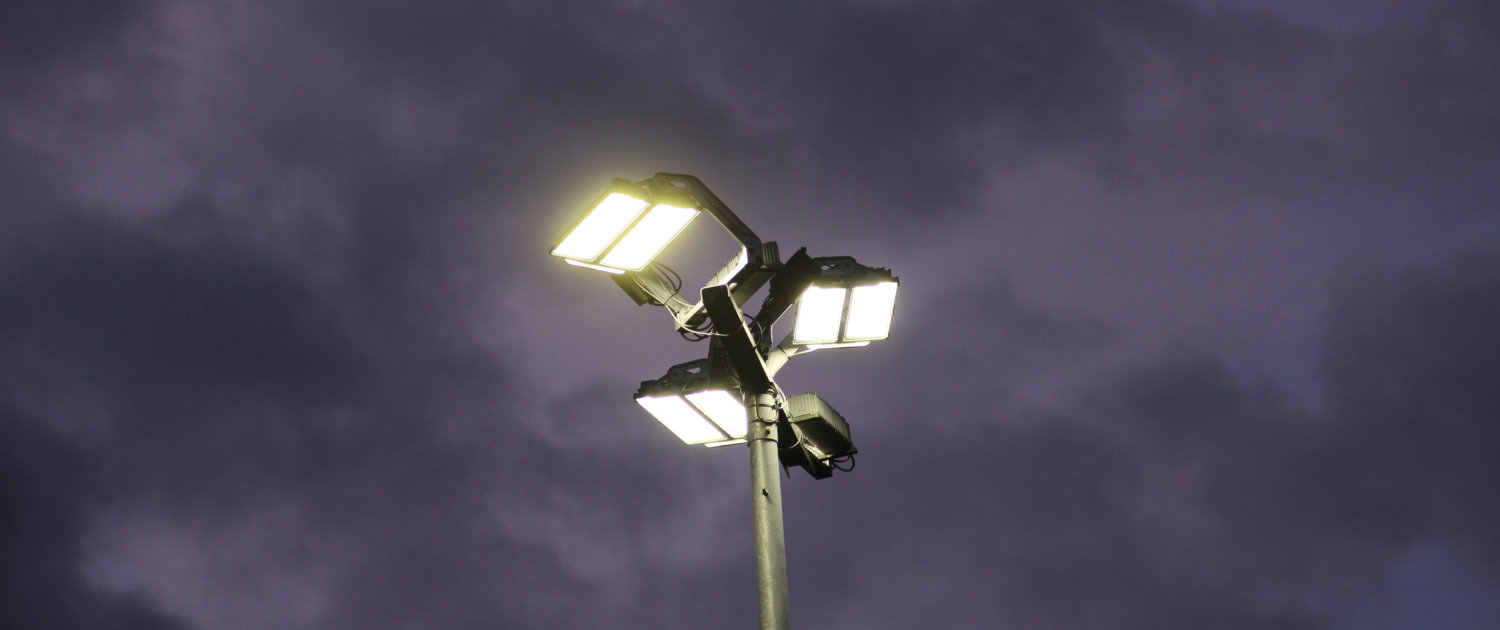Almost every one of Switzerland's more than 2000 municipalities has its own sports ground. Even when it's dark, football or tennis is played there and athletics are practiced. This is made possible by floodlights. For several years now, conversions to energy-saving LED lighting have been supported by the ProKilowatt funding instrument. Since the beginning of 2024, a new ProKilowatt program has been running with a focus on football pitches.
On this Friday evening in early February, the Bodenweid sports ground in Bern is a hive of activity. The YB women's U-14 team is training on one pitch, two senior teams are playing against each other on another and juniors are running in on another pitch. Depending on the season, up to 20 sports clubs use the facility - mainly for football - even in the evenings.
The five artificial turf pitches are illuminated by floodlights. What is striking is that the light on one side of the pitch is clearer, the colors are vibrant and you think you can see every blade of grass - HD quality, so to speak. The reason: the lighting on part of the facility was renovated in 2022. Nine candelabras were converted to LED. Six candelabras are still fitted with the old metal halide lamps. The lighting conditions there are more blurred and diffuse.
Because it is "only" training mode on this evening, the LED lights/spotlights are not operated at full load. This is an advantage over the old lamps, which cannot be dimmed. The replacement of the old lamps was financially supported by the ProKilowatt funding program.
In a video interview with energeiaplus, Adrian Gerber explains the advantages of the new LED lights - in terms of maintenance and energy consumption. Adrian Gerber is site manager of the Bodenweid/Weissenstein sports facilities in the city of Bern.
In Zug, too, the lighting in all sports facilities has been renewed in recent years. The stadium, grass pitches, street field hockey field and athletics facilities are now illuminated with LEDs. LED lights were installed in a total of 141 floodlight masts, which, unlike the old lamps, are dimmable. The lighting consumed almost 300'000 kWh of electricity per year before the renovation. Now it is just under half as much.
LED for Muri AG and Zug
Another example. The sports facility of the Swiss football club FC Muri in the canton of Aargau. The facility looks back on over 70 years of history. Women and men, juniors and seniors from various leagues train there - in summer and winter. Switched to LED in fall 2022. The lighting can now be regulated as required. there is 50% light intensity for training sessions, 75% light intensity for regional league matches and full lighting (100% light intensity) for first division matches.
As it was not possible to implement a cable connection, a wireless solution was chosen for dimming the lighting. "The biggest advantage of the three dimming levels is certainly the electricity and cost savings," says Jimmy Sagri, member of the FC Muri board, on the club's website.
Bern, Muri and Zug are three of almost 160 measures supported by the ProKilowatt "effeSPORT" program. The program was launched in 2021 with the aim of providing a financial incentive to promote the refurbishment of lighting on Swiss sports fields with modern LED technology and to replace old metal halide lamps with LEDs.
Metal halide lamps are still widely used on Swiss sports fields. Although they are powerful, they consume a lot of energy. They also need a start-up time of at least a quarter of an hour to reach full power. This means that the floodlights cannot be switched on at the start of training or a match. In addition, they cannot be dimmed. Whether training or match - the metal halide lamps always run at full power and not only fully illuminate the football pitch or tennis court, but also the immediate surroundings. This is known as scattered light, which is disturbing for the environment and the neighborhood.
These disadvantages do not apply to LEDs. LEDs shine where light is needed and as brightly as necessary. And you also save a lot of electricity - up to 65%. In addition, LED lights are more durable, which is another advantage when you consider that a lifting platform is always needed to replace the lights.
From effeSPORT to LEDforFOOT
The ProKilowatt "effeSPORT" program is now coming to an end, earlier than planned. The new ProKilowatt program "LEDforFOOT.ch" has been in place for football pitches since January 2024. Energeiaplus spoke with Giuseppina Togni to take stock of the expiring "effeSport" program and look ahead to the new "LED for FOOT" program.
The effeSPORT funding program is now coming to an end, earlier than planned. The new LEDforFOOT.ch funding program has been available for football pitches since January 2024. Energeiaplus took stock of effeSport with Giuseppina Togni and looked ahead to LEDforFOOT.
Energeiaplus: On the effeSPORT homepage you can read: "The program no longer has a budget and will not be extended." What is the reason for this?

Giuseppina Togni is project manager of effeSPORT and LEDforFOOT, Image: zvg
Giuseppina Togni: We had a budget of just over one million francs. The program was very popular, not least because you can convince the authorities to renew the lighting on sports fields and thus save energy with a modest amount of funding from the federal government.
The new LEDforFOOT funding program for football pitches has now been launched.
Why this focus on football pitches?
There are still many football pitches throughout Switzerland with old, energy-intensive metal halide lamps. We support each replaced light with 350 francs. This is intended as an incentive for operators to switch to energy-saving and long-lasting LED technology.
The aim of effeSPORT was to modernize 350 sports fields throughout Switzerland. Has this been achieved?
The almost 160 projects that we will have supported by the end of the program correspond almost exactly to 350 sports fields. For tennis, there are usually four courts, and for football pitches there are often two.
However, the electricity savings are more important to us because this figure is binding in our contract with ProKilowatt (ProKilowatt is the federal government's funding program for electricity-saving measures). Our goal was to save 3'025 MWh of electricity per year. This target was exceeded. How many systems are used to achieve this is not relevant for us.
Did effeSPORT support every renovation project? Or were there specifications?
Around 20% of applications were rejected. The most important requirements were that the lighting should be dimmable and that asymmetrical luminaires should be used to keep light pollution as low as possible.
Is it necessary to support projects such as effeSPORT if clubs can raise the money themselves, as examples on the "The green jersey" homepage show?
After all, the projects can only be realized if the financing is guaranteed. It is well known that sports clubs have little money. Support from the municipality or platforms such as "Das grüne Trikot" is therefore very important. effeSPORT guarantees a small amount of funding (approx. 10%), but sets requirements in terms of quality and energy saving, which is also greatly appreciated by the planners.
And what is the goal of LEDforFoot? How many courts are to be lit with LEDs in five years?
Most of the more than 2,000 competition pitches are still equipped with conventional floodlights. The aim is to replace the lighting on around 500 sports fields and thus save around 11,500 kWh of electricity per year and sports field.
ProKilowatt, the funding program of the Swiss Federal Office of Energy, supports non-economic electricity-saving measures in industrial and service companies and households. The subsidy, which can amount to up to 30% of the investment costs, is intended to provide incentives to renew existing systems and invest in highly efficient technologies. The projects and programs with the best cost-benefit ratio are awarded the subsidy.
In the case of projects, the subsidies go directly to the company implementing the measure. In the case of programs, the SFOE's subsidies are paid out to the participating companies by a "third party", the so-called program sponsor (e.g. industry association, engineering firm or energy supply company).
A municipality can apply directly to ProKilowatt for funding for the energy-efficient refurbishment of sports field lighting as part of a project application. Alternatively, the municipality can apply to an ongoing ProKilowatt program such as "LED for FOOT" to apply for appropriate support. All programs can be found here.
Text, video, interview, picture: Brigitte Mader, Communications, Swiss Federal Office of Energy





 EnergieSchweiz
EnergieSchweiz shutterstock
shutterstock
Neuste Kommentare